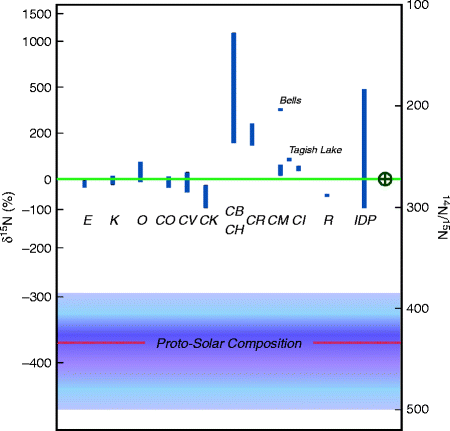
For light elements (the bottom left of the graph), the stable isotopes are the ones with the same numbers of protons and neutrons and hence the ‘line of stability’ follows the straight line of N = Z. For example, the stable isotope carbon-12 has 6 protons and 6 neutrons.
- Isotopes Of Nitrogen Wikipedia
- Isotopes Of Nitrogen With Mass Numbers
- Isotopes Of Nitrogen Pictures
- Common Isotopes Of Nitrogen
- Nitrogen has two isotopes, N-14 and N-15, both of which are used in various applications. N-15 is used for the production of the radioisotope O-15 which is used in PET. N-15 is also used to study the uptake of Nitrogen in plants and the metabolism of proteins in the human body. N-14 is used for the production of the PET radioisotope C-11.
- In this case, the article authors sampled nitrogen and oxygen isotopes of nitric acid deposition in Joshua Tree National Park and compared patterns to interpret two distinct areas where oxygen isotopes are a little heavier than natural “background” values. This finding is interpreted to reflect two artificial sources of the burning of.
If we got a straight line all the way, then this would tell us that the stable isotopes have the same number of neutrons as protons. However, this is not the case. The line curves upwards. Stable isotopes of the heavier elements (top right of the graph) have more neutrons than protons. For example, Gold-197 is stable. It contains 79 protons and 118 neutrons.
The neutrons in a nucleus can be thought of as acting as a kind of glue to hold the nucleus together. The positively charged protons are in a very confined space but would rather not be, due to the fact that they repel each other.
However, protons and neutrons are all attracted to each other as a result of another force - the strong nuclear force (see below). The neutrons don't contribute any repulsive effects because they are neutral. So having more neutrons around can help to hold the nucleus together. Notice that no amount of neutrons can hold a nucleus together once it has more that 82 protons – the line stops at Z = 82! All of the elements with an atomic number greater than 82 have only unstable isotopes.
The abundance of the nitrogen isotopes in several sources of nitrogen have been determined. In atmospheric nitrogen the absolute ratio, N14/N15, is 272.0 ± 0.3. Small variations were observed for various sources of compressed gas but the isotopic composition of the nitrogen isotopes of the atmosphere was constant, to 1.
Isotopes Of Nitrogen Wikipedia

| Isotope | Atomic mass (Da) | Isotopic abundance (amount fraction) |
|---|---|---|
| 14N | 14.003 074 004(2) | [0.995 78, 0.996 63] |
| 15N | 15.000 108 899(4) | [0.003 37, 0.004 22] |

The primary reference material for the relative abundance measurements of nitrogen isotopes is atmosphericN2, which is homogeneous with respect to analytical uncertainties and is assigned aδ15Nair value of 0 ‰. Relative isotope-ratio measurements of nitrogen commonly have uncertainties of the order of 0.1 ‰,which is significantly smaller than the reported uncertainty of the calibrated 'best measurement'(1.1 ‰). Variations in the isotopic composition of nitrogen in chemical reagents and natural terrestrialsystems are known to exceed 200 ‰, which is much larger than the uncertainty due to either relative or'absolute' isotope-ratio measurements. Therefore, the accuracy and precision of the standard atomicweight of nitrogen are limited almost entirely by real variations, hence the annotation 'r'.

Measurable variations in the isotope abundances (and atomic weights) of nitrogen are found in most nitrogencompounds. The vast majority of chemical reagents, manufactured fertilizers, and environmentalsamples have δ15N values between about −15 and +20 ‰ which corresponds to x(15N) = 0.003 61 to 0.003 74 andAr(N) = 14.006 67 to 14.006 80. Isotope fractionations are caused by physical, chemical, and biologicalprocesses. Some of the largest common effects in the natural environment are caused by microbially mediatedoxidation and reduction reactions and by ammonia or nitric acid evaporation.
The most 15N-enriched occurrences reported in nature include dissolved nitrate that had undergone partial microbialreduction (denitrification) in groundwater (e.g., δ15N = +103 ‰, x(15N) = 0.004 039, andAr(N) = 14.007 10), and nitrate in Antarctic ice that may have been fractionated by evaporation ofHNO3 with δ15N = 150 ‰, x(15N) = 0.004 210, and Ar(N) = 14.007 27.
The most 15N-depleted substances from natural terrestrial environments include nitrous oxide from groundwater undergoing microbial denitrification (δ15N = −55 ‰). Still lower values have been reported forNOx escaping from a nitric acid production facility (δ15N = −150 ‰, x(15N) = 0.003 115, andAr(N) = 14.006 18), and for a commercially available potassium nitrite reagent (δ15N = −80 ‰, x(15N) = 0.003 371, and Ar(N) = 14.006 43).
The annotation 'g' reflects the fact that anumber of samples are known to have atomic weights outside the uncertainties of the standard atomicweight of nitrogen. Many thousands of isotopic analyses of nitrogen have been made since the 1950s; nevertheless,more occurrences of extreme values may be expected as work expands in the fields of contaminant hydrology,biology, and atmospheric chemistry.
Atomic weights of the elements 2009 by M.E. Wieser and T.B. Coplen. Pure Appl. Chem. 2011 (83) 359-396
CIAAW
Isotopes Of Nitrogen With Mass Numbers
Nitrogen
Ar(N) = [14.006 43, 14.007 28] since 2009
The name derives from the Latin nitrum and Greek nitron for 'native soda' and genes for 'forming'.Nitrogen was discovered by the Scottish physician and chemist Daniel Rutherford in 1772.
Isotopes Of Nitrogen Pictures
Natural variations of nitrogen isotopic composition
Common Isotopes Of Nitrogen
Isotopic reference materials of nitrogen.
